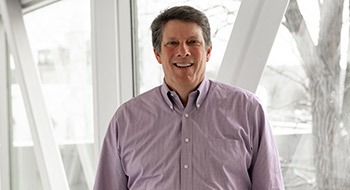Creating a Cost-Effective Cure
Researchers design a potent latency reversing agent that targets the HIV reservoir and boosts immune responses
By Jeffrey Laurence, M.D.
Research question
A special subset of CD4+ T cells—the memory cell—appears responsible for sequestering the vast majority of latent virus in the HIV reservoir, the primary obstacle to an HIV cure.
In association with antiretroviral therapy (ART), latency reversing agents (LRAs)—drugs designed to drive out dormant HIV and eradicate the HIV reservoir—have been developed over the past decade and tested in a variety of “shock and kill” cure trials. All have had disappointing results, with minimal changes in the latent reservoir.
One clue to a new type of LRA came from the fact that latent HIV is first established mainly in HIV-specific CD4 cells and might remain there in those individuals starting ART very early after infection.

Dr. Eric Arts
Photo by Megan Morris, Schulich School of Medicine & Dentistry
A Canadian group led by amfAR grantee Eric Arts, PhD, developed HLP—a dead, HIV-like particle that could activate those specific T cells and wake up dormant HIV. The concept was explored using cells from individuals on ART for two to three years who started ART during acute HIV infection, or very shortly thereafter. As hoped, in the test tube HLP induced almost 100-fold greater latency reversal than existing agents.
But those who started ART at such an early stage represent less than 5% of all people living with HIV worldwide. What about people who started ART later in the course of their infection?
Findings
Dr. Arts’ group, with colleagues from Johns Hopkins, the NIH, the UK, and Uganda, looked at T cells obtained from 32 PLWH from the U.S., Canada, and Uganda who had been on ART for a median 13.2 years. HLPs that could recognize subtypes of HIV found primarily in the West—B—as well as in Africa—A and D—were designed.
HLPs proved equally effective in these groups as in the initial studies, leading to 100 to 1,000-fold more HIV release than previous LRAs. The researchers speculated that multiple injections of HLP into muscle, like a vaccination, could also boost anti-HIV immune responses.
Impact
The authors concluded that “HLP serves as both a latency reversal agent as well as treatment that will boost HIV-1-specific immune responses. The potency of HLP on [blood] samples from Canada, the US, and Uganda suggests the possibility of a global, cost-effective HIV-1 cure strategy for the future.”
amfAR’s role
amfAR was a funder of this research.
Original article
http://www.ncbi.nlm.nih.gov/pubmed/38444369
Dr. Laurence is amfAR’s senior scientific consultant.
Share This:
